If you’re like most women, you want a very particular type of body.
You want to be lean but not skinny, toned but not “bulky,” and you want a flat stomach, shapely legs, and a gravity-defying butt.
You can have all these things. And you don’t need top-shelf genetics or to have done a lifetime of training, either.
You have to know what you’re doing, though.
Forget what the fitness magazines have told you—you don’t become a “goddess” by starving yourself and doing a masochistic amount of cardio.
Instead, you need to take a completely different approach—a much healthier, more enjoyable, and sustainable one.
In this article, you’ll learn the best workout routine for women, as well as a 3-month body recomposition workout plan for females that’ll get you on your way to building the body of your dreams in no time.
Key Takeaways
- To get a lean, toned body without looking bulky, you need to prioritize heavy strength training and progressive overload—not starvation diets or endless cardio.
- Our 3-month female body transformation plan combines strength and cardio workouts designed to burn fat and build muscle, with extra focus on glutes, legs, and upper body definition.
- Stick to the schedule, lift heavy weights, eat enough protein (about 1 gram per pound of body weight), and use a moderate calorie deficit (20-to-25%) to lose fat without losing muscle.
- Do cardio in moderation—1 HIIT and 1 steady-state session per week—to support fat loss and fitness without compromising recovery.
- To get the most out of your 3-month female body transformation plan, consider using a high-quality protein powder to help you reach your daily protein target, creatine to support recovery and muscle growth, and a pre-workout to enhance energy, focus, and performance.
Table of Contents
+
The Ultimate Workout Plan for Women
Below is the schedule for our ultimate body recomposition workout plan for females. It lasts four weeks; complete it three times to finish your 90-day female body transformation.
We’ll talk about the specifics of each day soon. For now, familiarize yourself with the schedule:
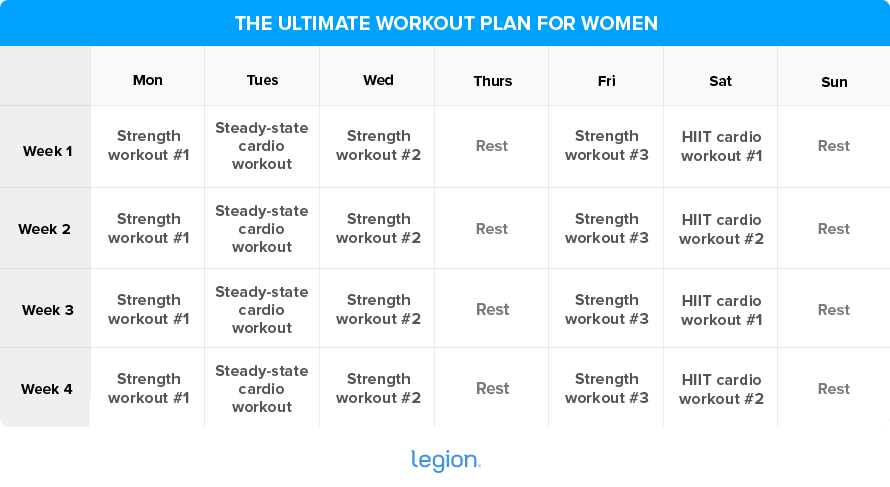
The Best 3-Month Body Transformation Plan for Females
Our female body transformation plan includes the perfect mix of strength training and cardio to transform your body in just 3 months.
Make sure you take rest days as per the calendar, too. This 3-month workout plan for women is short and intense, so you need to give your body time to recover.
Strength Workouts
Most body recomposition workout plans for females emphasize the wrong types of exercises.
To transform your body quickly, you must get as strong as possible on compound exercises (exercises that train multiple muscle groups simultaneously), not futz around with isolation and machine exercises.
You also need to get stronger over time.
If you stop getting stronger, your muscles will eventually stop getting bigger, and your physique will stop improving. That’s why you should also strive to add weight or reps to every exercise in every workout to maximize the transformative effects of weightlifting.
Our gym workout routine for women features strength workouts based on the classic “push pull legs” routine. However, we’ve modified them to include extra work for your legs and butt since that’s what most ladies want to focus on.
Do the exercises in the order given and use the rep ranges and rest times provided.
Cardio Workouts
Our 3-month female workout plan for weight loss includes two weekly cardio workouts: one HIIT workout and one steady-state cardio workout.
You can do HIIT on any cardio equipment, but if your goal is to preserve muscle and strength (and it should be), your best choices are cycling and rowing.
Research shows that these forms of cardio can enhance weightlifting performance and don’t stress your body as much as other forms of cardio, like running, which means they’re less likely to interfere with your recovery.
For your steady-state cardio sessions, do any form of low-impact exercise you enjoy, such as walking, swimming, cycling, or rucking.
Strength Workout #1: Legs and Glutes
1. Barbell Back Squat
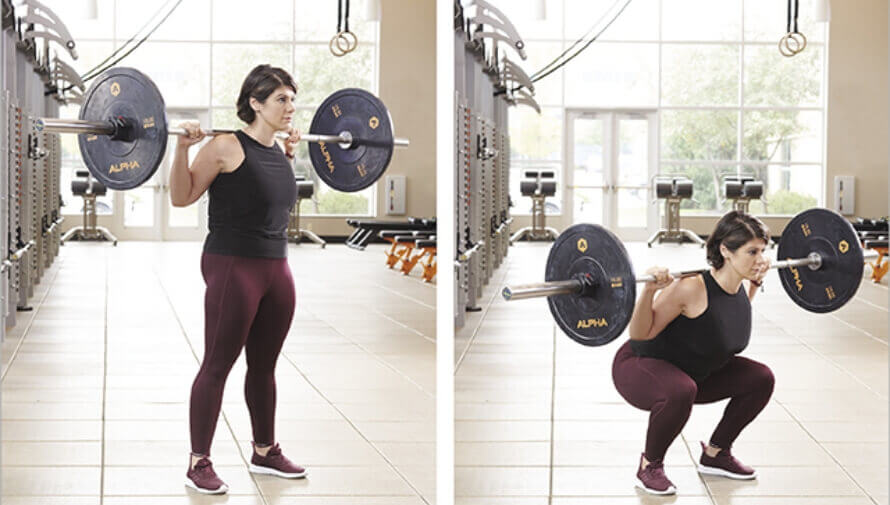
3 sets | 6-to-8 reps | Rest: 2-to-3 min
The barbell back squat is an ideal addition to our body recomposition workout plan for females because it allows you to lift heavy weights safely and progress regularly, making it fantastic for building muscle, gaining strength, and burning calories. It’s also an outstanding glute builder when you squat to parallel or deeper, so it’s perfect for developing the muscle groups most women want to improve.
How to:
- Position a barbell in a squat rack at about mid-chest height.
- Step under the bar, pinch your shoulder blades together, and rest the bar above the bony ridges on the bottom of your shoulder blades.
- Lift the bar out of the rack, take 1-to-2 steps backward, and place your feet slightly wider than shoulder-width apart, with your toes pointing slightly outward.
- Keeping your back straight, sit down and push your knees out in the same direction as your toes.
- Stand up and return to the starting position.
2. Bulgarian Split Squat
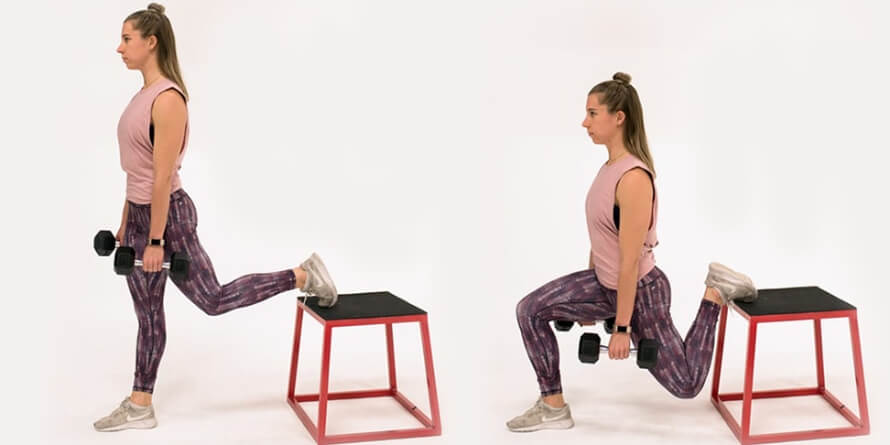
3 sets | 8-to-10 reps | Rest: 2-to-3 min
The Bulgarian split squat is a fantastic leg and glute exercise. Because it trains each side of your body independently, it’s also useful for finding and fixing muscle imbalances.
How to:
- While holding a dumbbell in each hand, stand about two-to-three feet in front of a bench.
- With your right foot (and heel in particular) firmly planted, place the top of your left foot on the bench behind you.
- Look at a spot on the floor six-to-ten feet in front of you and lower your butt toward the floor by bending at your right knee.
- Keep lowering yourself until your right knee bends to 90 degrees.
- Stand up and return to the starting position.
3. Romanian Deadlift
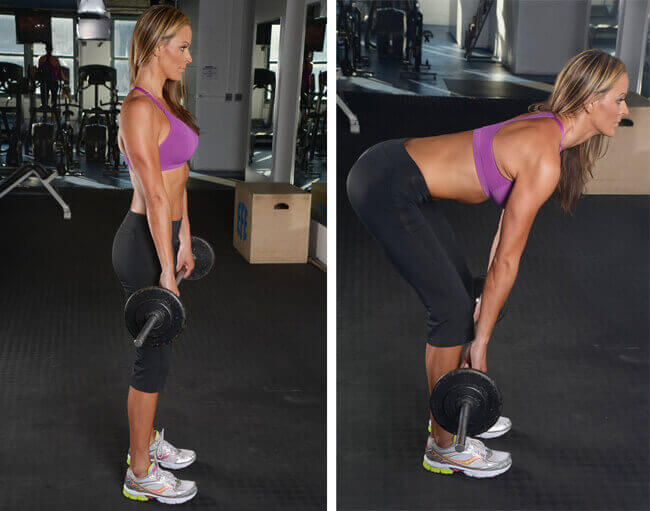
3 sets | 8-to-10 reps | Rest: 2-to-3 min
The Romanian deadlift trains your entire posterior chain (the muscles on the back side of your body) and emphasizes the hamstrings and glutes.
How to:
- Stand up straight holding a loaded barbell with a shoulder-width, overhand grip (palms facing toward you).
- Flatten your back and lower the weights toward the floor in a straight line while keeping your legs mostly straight, allowing your butt to move backward as you descend.
- Once you feel a stretch in your hamstrings, bend your knees slightly more, and continue lowering the weights until your lower back begins to round.
- Reverse the movement and return to the starting position.
4. Hip Thrust
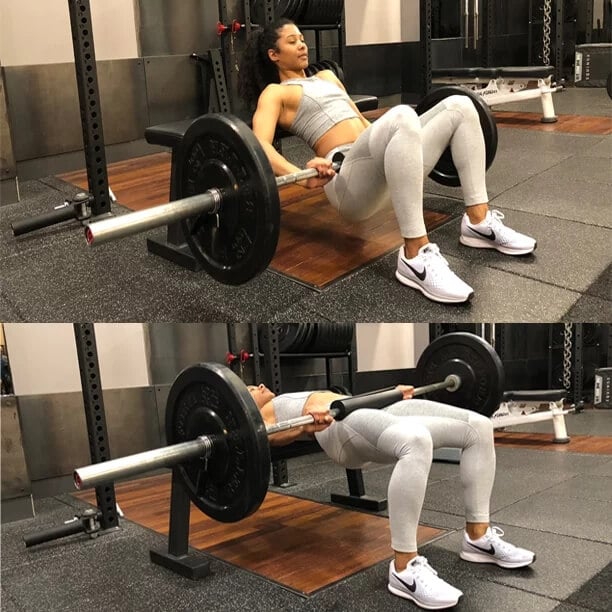
3 sets | 8-to-10 reps | Rest: 3-to-5 min
The positioning of the barbell during hip thrusts forces your glutes to work hard throughout the entire range of motion, which is a unique benefit of this exercise and the reason we included it in our body recomposition workout plan for females.
How to:
- Sit on the ground with your shoulders resting against a bench that’s perpendicular to your body.
- Roll a barbell over your thighs so it sits in your hip crease.
- Plant your feet on the floor about shoulder-width apart with your knees bent at a 90-degree angle.
- Push the bar upward by pressing through your heels until your upper body and thighs are parallel to the ground and your shins are vertical.
- Reverse the movement and return to the starting position.
Strength Workout #2: Upper Body
1. Incline Dumbbell Press
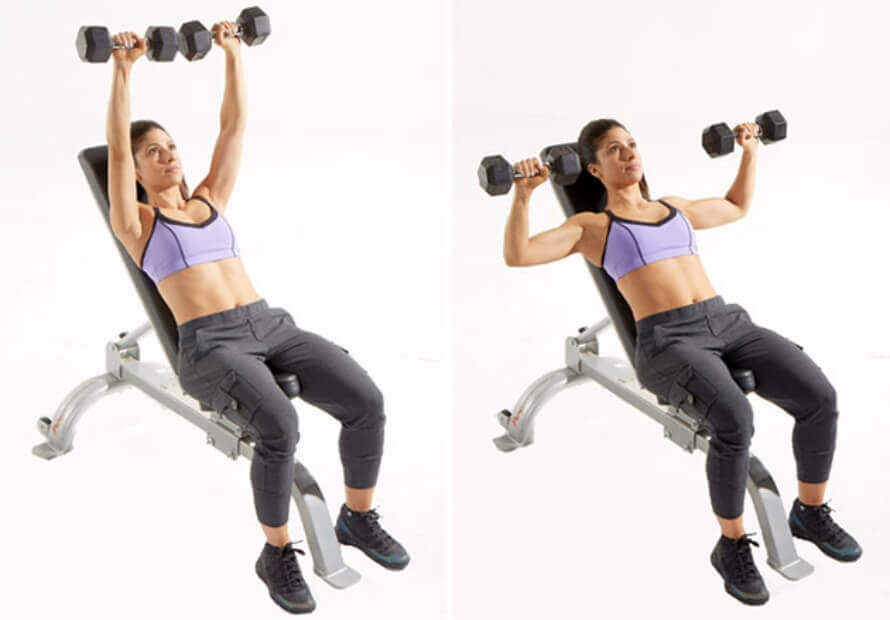
3 sets | 6-to-8 reps | Rest: 2-to-3 min
The incline dumbbell press builds almost every major muscle in your upper body, including your pecs, triceps, and deltoids, making it a worthy addition to any female workout plan for weight loss.
How to:
- While lying on a bench angled at 30-to-45 degrees, hold a dumbbell in each hand and rest them on your thighs.
- Lie back, hoisting the dumbbells up so you’re holding them on either side of your chest by giving them a nudge with your thighs.
- Press the dumbbells over your upper chest until your elbows are locked.
- Reverse the movement and return to the starting position.
2. Shoulder Press
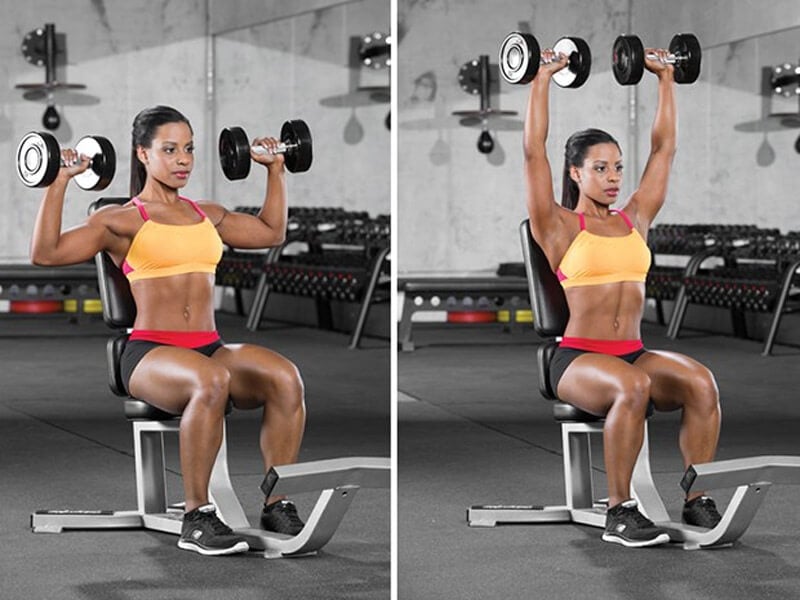
3 sets | 8-to-10 reps | Rest: 2-to-3 min
The shoulder press trains your shoulders through a longer range of motion than barbell overhead pressing exercises, which is generally beneficial for muscle growth.
How to:
- Sit on an upright bench and hold a dumbbell in each hand, resting them on your thighs.
- Hoist the dumbbells up so you’re holding them just above your shoulders with your palms facing away from you.
- Press the dumbbells toward the ceiling until your arms are straight.
- Lower the dumbbells and return to the starting position.
3. Dumbbell Side Lateral Raise
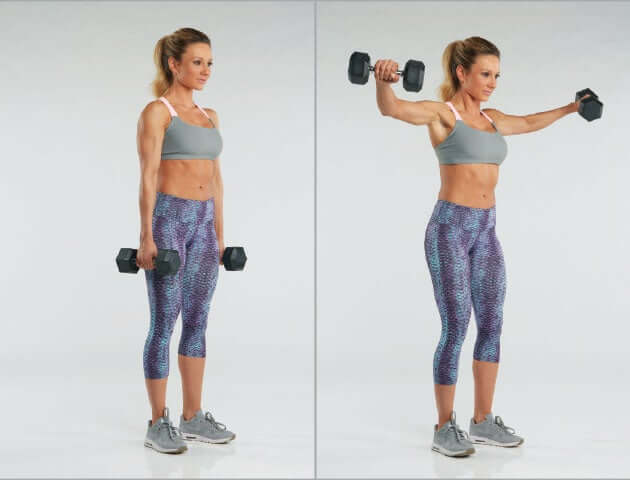
3 sets | 10-to-12 reps | Rest: 1-to-2 min
The dumbbell side lateral raise is a solid addition to a 90-day body transformation plan for females because it isolates the “side delts,” which helps develop the “defined” shoulder look many women like.
How to:
- Stand up straight with a dumbbell in each hand.
- Keeping your back straight and your core tight, raise the dumbbells out to the side until your upper arm is parallel to the floor. You don’t have to keep your arms perfectly straight—having a small bend in your elbows is normally more comfortable.
- Reverse the movement and return to the starting position.
4. Dumbbell Overhead Triceps Extension
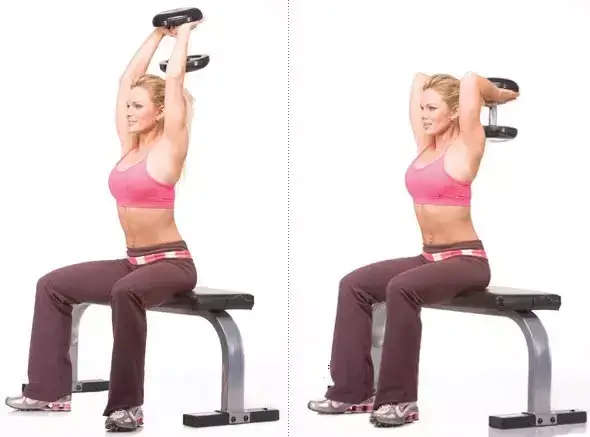
3 sets | 10-to-12 reps | Rest: 1-to-2 min
The dumbbell overhead triceps extension is a top dumbbell exercise for the triceps because it fully stretches the triceps, which is vital for maximizing muscle growth.
How to:
- Sit up straight on a bench.
- Grip one end of a dumbbell with your palms facing upward and lift it overhead.
- Lower the weight until it’s behind your head by bending at the elbows.
- Extend your elbows to return to the starting position.
Strength Workout #3: Legs and Back
1. Barbell Deadlift
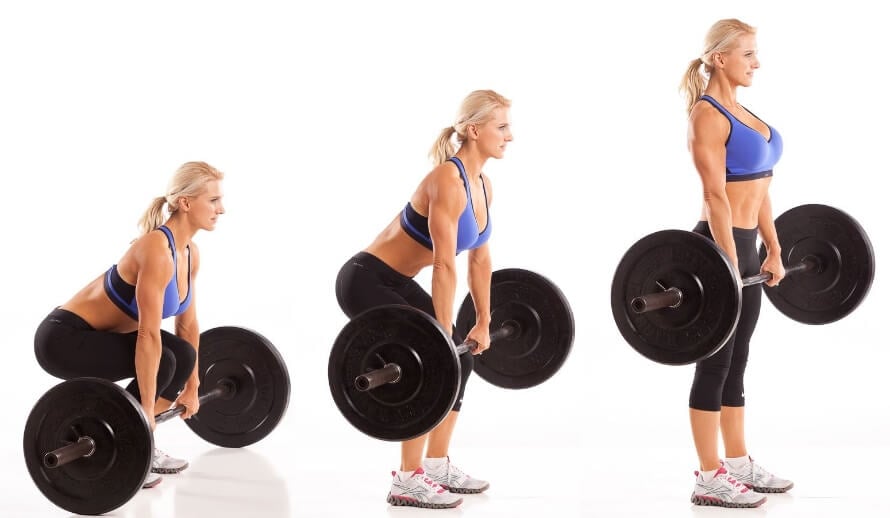
3 sets | 6-to-8 reps | Rest: 2-to-3 min
The deadlift is hands down the best exercise for training your entire posterior chain. It also allows you to use some of the heaviest weights in any of your workouts, which means it’s ideal for gaining strength and muscle.
How to:
- Position your feet slightly narrower than shoulder-width apart with your toes pointed slightly out.
- Move a loaded barbell over your midfoot so it’s about an inch from your shins.
- Grip the bar just outside your shins with your palms facing you.
- Flatten your back and drive your body upward and slightly back by pushing through your heels until you’re standing up straight.
- Reverse the movement and return to the starting position.
Tip: If you can’t do conventional deadlifts, try sumo deadlifts or trap-bar deadlifts instead. They’re as effective as the conventional deadlift, but some find them more comfortable.
2. Reverse Lunge
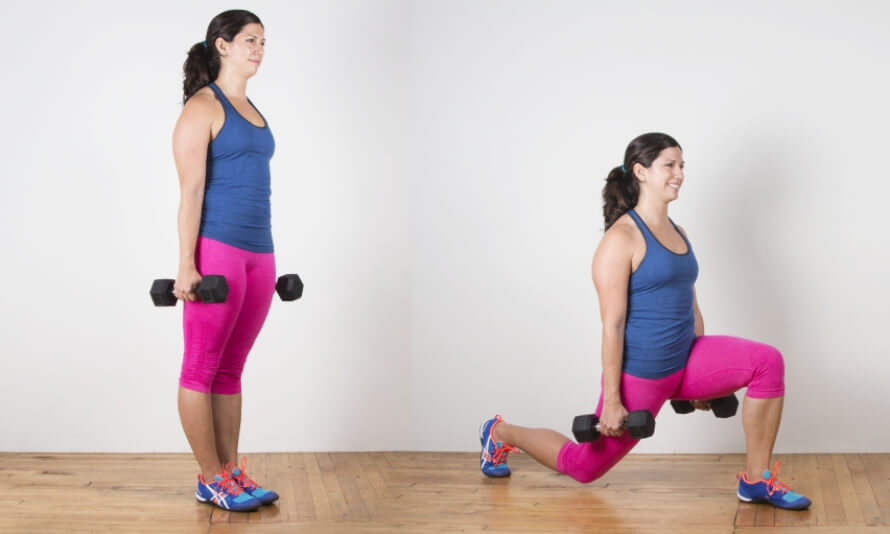
3 sets | 8-to-10 reps | Rest: 2-to-3 min
While all lunge variations train your entire lower body to a high degree, the reverse lunge emphasizes the glutes the most.
How to:
- Holding a dumbbell in each hand, stand up straight with both feet about hip-width apart.
- Step back about 2-to-3 feet with your left leg, placing most of your weight on your right foot.
- Lower your body by bending both knees until your left knee touches the floor.
- Push off the floor with your right foot and lean slightly backward, allowing your legs to straighten.
- Once you’re standing, bring your left foot forward so that it’s next to your right foot, then repeat on your left side.
3. One-arm Dumbbell Row
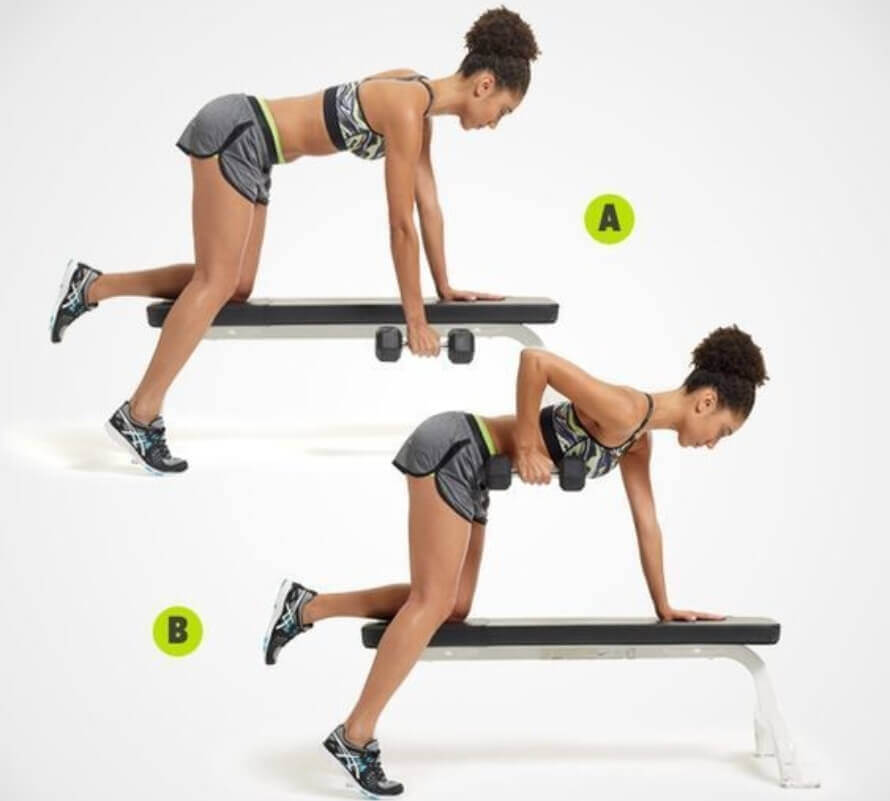
3 sets | 8-to-10 reps | Rest: 2-to-3 min
The one-arm dumbbell row trains your entire back and allows you to lift more weight per side than you can on barbell back exercises, which is generally better for muscle growth, strength gain, and fat loss.
How to:
- Hold a dumbbell in your right hand.
- Plant your left knee and hand firmly on a bench, your right foot on the floor a foot or two from the bench, and let your right arm hang straight toward the floor.
- Keeping your back straight, pull the weight upward until it touches your torso, and then return the dumbbell to the starting position.
4. Lat Pulldown
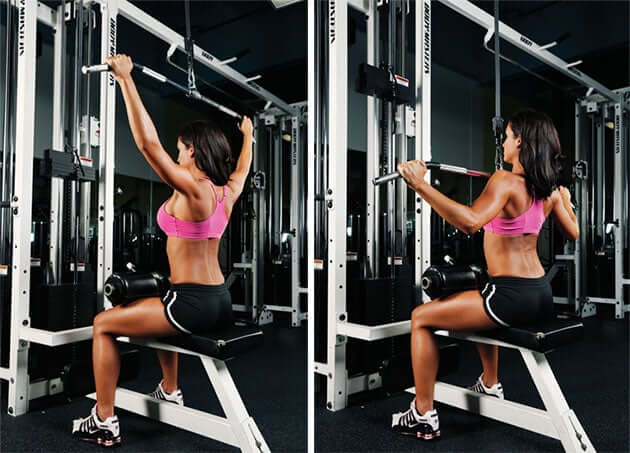
3 sets | 8-to-10 reps | Rest: 2-to-3 min
The lat pulldown is an excellent exercise for training your lats, biceps, and traps, especially for beginners who struggle to do chin-ups and pull-ups.
How to:
- Adjust the thigh pad of a lat pulldown machine so that it locks your lower body in place, then stand up and grab the bar with an overhand grip (palms facing away from you).
- While gripping the bar, sit down, allowing your body weight to pull the bar down with you.
- Nudge your thighs under the thigh pads and plant your feet on the floor.
- Pull the bar toward your chest.
- Once the bar is underneath your chin, reverse the movement and return to the starting position.
HIIT Cardio Workout #1: 6 x 30
This beginner-friendly HIIT workout includes short intervals and plenty of rest between sprints, making it easier to handle than many other HIIT routines. It’s less intense but still significantly boosts calorie burning and fitness.
How to:
- On an exercise bike or rowing machine, sprint for 30 seconds at about 90% of your max effort, followed by 2 minutes of active recovery.
- Repeat 6 times for a total of 15 minutes of exercise.
HIIT Cardio Workout #2: 10 x 1
You burn a ton of calories in this HIIT workout because the sprints are longer and the rests are shorter.
How to:
- On an exercise bike or rowing machine, sprint for 1 minute at about 90% of your max effort, followed by 1 minute of active recovery.
- Repeat 10 times for a total of 20 minutes of exercise.
Steady-State Cardio Workout
For your steady-state cardio workout, spend 30-to-60 minutes doing a low-impact form of exercise that you enjoy, like walking, swimming, cycling, or rucking.
Diet and Nutrition
1. Eat the right number of calories.
Creating a calorie deficit of 20-to-25% (eating 20-to-25% fewer calories than you burn every day) will help you lose fat lickety-split without losing muscle or wrestling with excessive hunger, lethargy, and the other hobgoblins of low-calorie dieting.
To learn more about how many calories you should eat to transform your body composition, check out the Legion Calorie Calculator here.
2. Eat enough protein.
High-protein dieting beats low-protein in every way, especially when you’re dieting to lose fat.
While following our body recomposition workout plan for women, eat around 1 gram of protein per pound of body weight daily.
And if you’re very overweight (body fat percentage of 30%+), you can reduce this to around 40% of your total daily calories.
3. Take the right supplements.
These supplements will help you optimize your performance and gains while following our workout plan for weight loss for females:
- Protein powder: Protein powder, such as whey or casein, provides your body with the nutrients needed to build muscle tissue and recover from workouts. For a clean and delicious protein powder, try Whey+ or Casein+.
- Creatine: Creatine boosts muscle and strength gain, improves anaerobic endurance, and reduces muscle damage and soreness from your workouts. For a natural source of creatine, try our creatine monohydrate, creatine gummies, or Recharge.
- Pre-workout: A high-quality pre-workout enhances energy, mood, and focus, increases strength and endurance, and reduces fatigue. For a top-tier pre-workout containing clinically effective doses of 6 science-backed ingredients, try Pulse with caffeine or without.
(If you’d like even more specific advice about which supplements you should take to reach your health and fitness goals, take the Legion Supplement Finder Quiz, and in less than a minute, you’ll know exactly what supplements are right for you.)
Scientific References +
- Murach, Kevin A., and James R. Bagley. “Skeletal Muscle Hypertrophy with Concurrent Exercise Training: Contrary Evidence for an Interference Effect.” Sports Medicine, vol. 46, no. 8, 1 Mar. 2016, pp. 1029–1039, https://doi.org/10.1007/s40279-016-0496-y.
- Konopka, Adam R., and Matthew P. Harber. “Skeletal Muscle Hypertrophy after Aerobic Exercise Training.” Exercise and Sport Sciences Reviews, vol. 42, no. 2, Apr. 2014, pp. 53–61, https://doi.org/10.1249/jes.0000000000000007.
- Caterisano, Anthony, et al. “The Effect of Back Squat Depth on the EMG Activity of 4 Superficial Hip and Thigh Muscles.” Journal of Strength and Conditioning Research, vol. 16, no. 3, 1 Aug. 2002, pp. 428–432, pubmed.ncbi.nlm.nih.gov/12173958/.
- Jones, Margaret T, et al. “Effects of Unilateral and Bilateral Lower-Body Heavy Resistance Exercise on Muscle Activity and Testosterone Responses.” Journal of Strength and Conditioning Research, vol. 26, no. 4, Apr. 2012, pp. 1094–1100, https://doi.org/10.1519/jsc.0b013e318248ab3b.
- Contreras, Bret, et al. “Barbell Hip Thrust.” Strength and Conditioning Journal, vol. 33, no. 5, Oct. 2011, pp. 58–61, https://doi.org/10.1519/ssc.0b013e31822fa09d.
- Campos, Yuri A. C., et al. “Different Shoulder Exercises Affect the Activation of Deltoid Portions in Resistance-Trained Individuals.” Journal of Human Kinetics, vol. 75, no. 1, 31 Oct. 2020, pp. 5–14, https://doi.org/10.2478/hukin-2020-0033.
- Landin, Dennis, and Melissa Thompson. “The Shoulder Extension Function of the Triceps Brachii.” Journal of Electromyography and Kinesiology, vol. 21, no. 1, Feb. 2011, pp. 161–165, https://doi.org/10.1016/j.jelekin.2010.09.005.
- Oranchuk, Dustin J., et al. “Isometric Training and Long-Term Adaptations: Effects of Muscle Length, Intensity, and Intent: A Systematic Review.” Scandinavian Journal of Medicine & Science in Sports, vol. 29, no. 4, 13 Jan. 2019, pp. 484–503, https://doi.org/10.1111/sms.13375.
- Park, Samho , et al. Comparative Study of the Biomechanical Factors in Range of Motion, Muscle Activity, and Vertical Ground Reaction Force between a Forward Lunge and Backward Lunge. June 2021, p. Physical therapy rehabilitation science 10(2):98-105, https://doi.org/10.14474/ptrs.2021.10.2.98.
- Park, Sanghoon, et al. “Comparative Analysis of Lunge Techniques: Forward, Reverse, Walking Lunge.” ISBS - Conference Proceedings Archive, 6 Nov. 2016, ojs.ub.uni-konstanz.de/cpa/article/view/6941.
- Jakobi, Jennifer M., and Philip D. Chilibeck. “Bilateral and Unilateral Contractions: Possible Differences in Maximal Voluntary Force.” Canadian Journal of Applied Physiology, vol. 26, no. 1, Feb. 2001, pp. 12–33, https://doi.org/10.1139/h01-002.
- Doma, Kenji, et al. “Kinematic and Electromyographic Comparisons between Chin-Ups and Lat-Pull down Exercises.” Sports Biomechanics, vol. 12, no. 3, Sept. 2013, pp. 302–313, https://doi.org/10.1080/14763141.2012.760204.
- Huovinen, Heikki T., et al. “Body Composition and Power Performance Improved after Weight Reduction in Male Athletes without Hampering Hormonal Balance.” Journal of Strength and Conditioning Research, vol. 29, no. 1, Jan. 2015, pp. 29–36, https://doi.org/10.1519/jsc.0000000000000619.
- Stokes, Tanner, et al. “Recent Perspectives Regarding the Role of Dietary Protein for the Promotion of Muscle Hypertrophy with Resistance Exercise Training.” Nutrients, vol. 10, no. 2, 7 Feb. 2018, p. 180, www.mdpi.com/2072-6643/10/2/180/pdf, https://doi.org/10.3390/nu10020180.
- Eckerson, Joan M., et al. “Effect of Creatine Phosphate Supplementation on Anaerobic Working Capacity and Body Weight after Two and Six Days of Loading in Men and Women.” The Journal of Strength and Conditioning Research, vol. 19, no. 4, 2005, p. 756, https://doi.org/10.1519/r-16924.1.
- Bassit, Reinaldo Abunasser, et al. “Effect of Short-Term Creatine Supplementation on Markers of Skeletal Muscle Damage after Strenuous Contractile Activity.” European Journal of Applied Physiology, vol. 108, no. 5, 3 Dec. 2009, pp. 945–955, https://doi.org/10.1007/s00421-009-1305-1.













